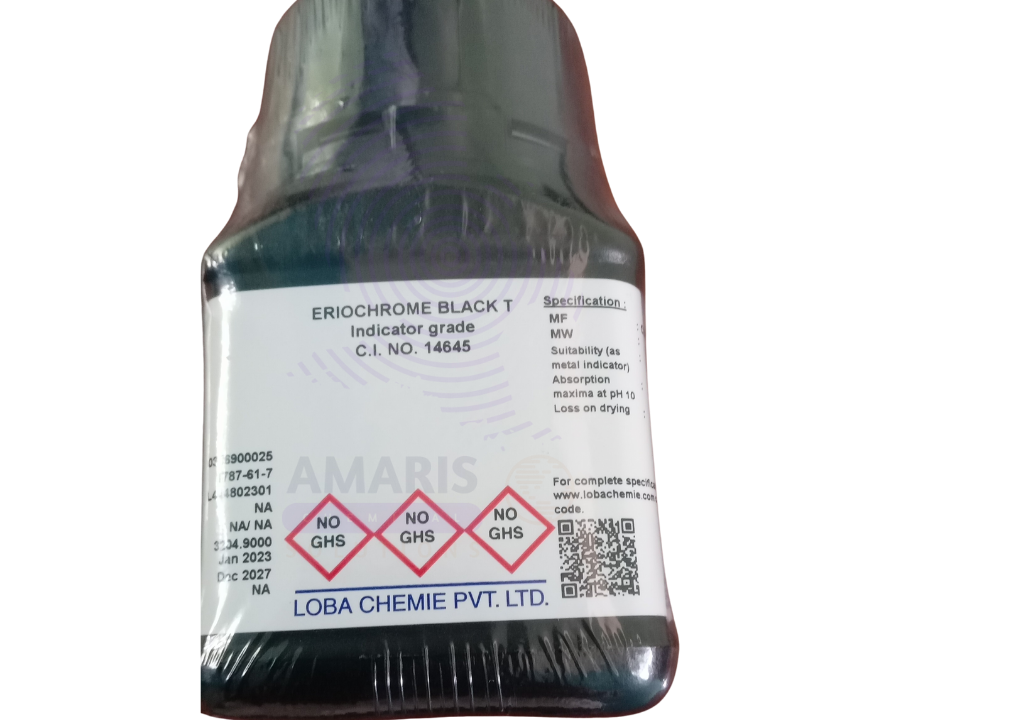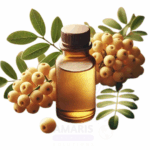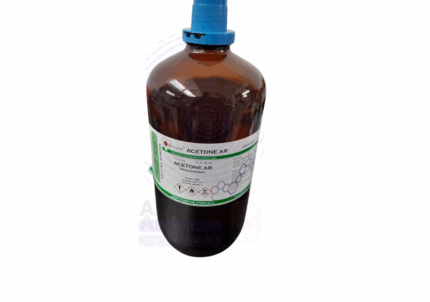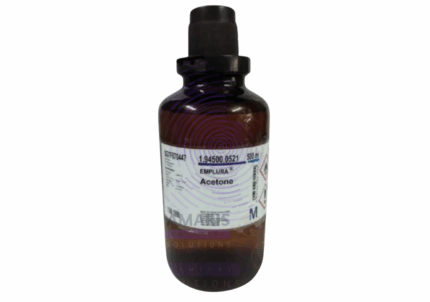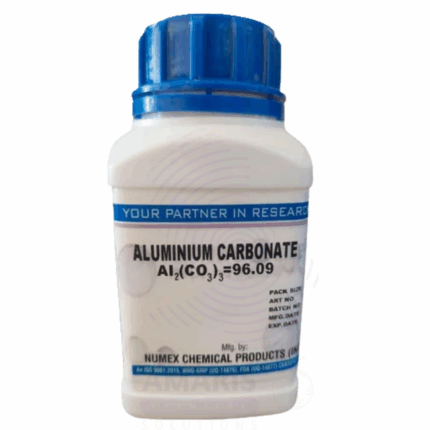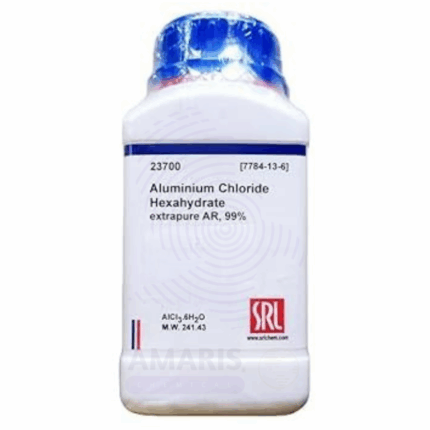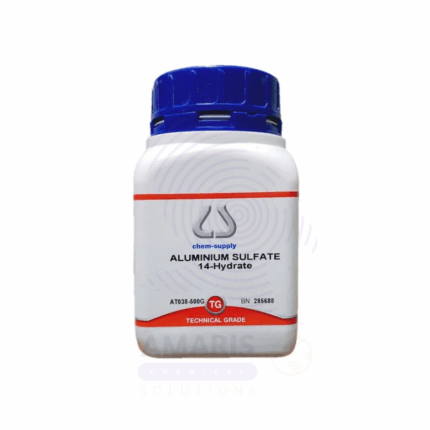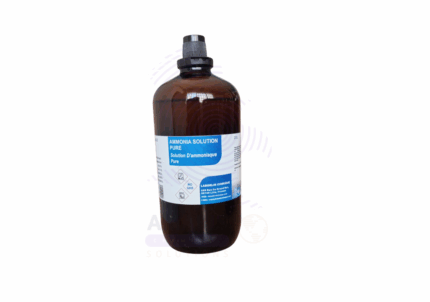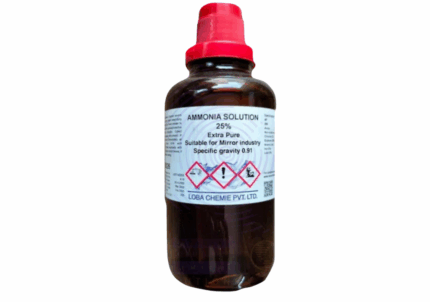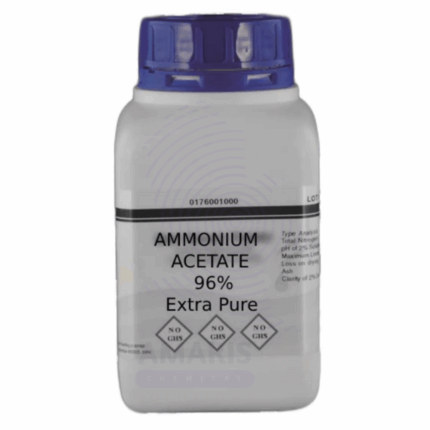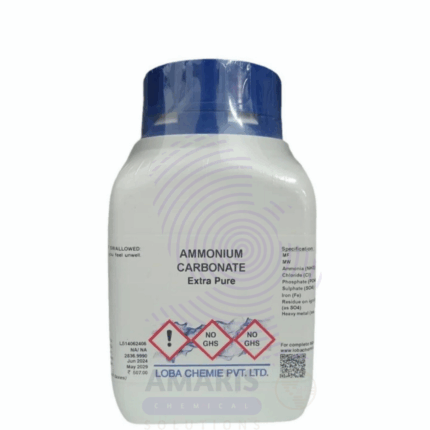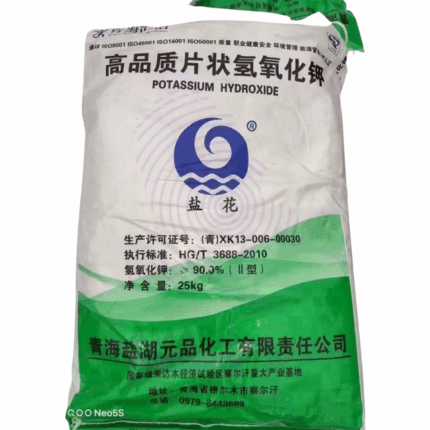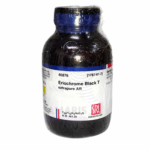
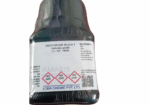

Eriochrome Extra Pure
$ 20.00 Original price was: $ 20.00.$ 19.89Current price is: $ 19.89.
Eriochrome Extra Pure—typically referring to Eriochrome Black T—is a complexometric indicator primarily used in EDTA titrations to detect metal ions, especially calcium (Ca²⁺) and magnesium (Mg²⁺) in water hardness analysis. In its extra pure grade, this dye ensures sharp, precise endpoint detection by minimizing impurities that could cause background coloration or interferences in spectrophotometric or volumetric determinations. It functions by forming a wine-red complex with metal ions, which turns blue when the metal is sequestered by EDTA. Suitable for high-precision analytical chemistry, it should be stored away from light and moisture to preserve stability.
Eriochrome Extra Pure
Primary Uses
- Complexometric indicator in EDTA titrations:
Used mainly for determining water hardness by detecting calcium and magnesium ions through color change. - Metal ion detection in solution:
Forms colored complexes with metal ions, aiding in qualitative and quantitative analysis. - pH-sensitive indicator in metal-ligand equilibria studies:
Its color shift helps determine end points in chelation reactions.
Secondary Uses
- Teaching and demonstration of coordination chemistry:
Commonly used in academic labs to illustrate complexation and titration techniques. - Indicator in soil and environmental testing:
Helps estimate divalent metal ion content in environmental water or soil extracts. - Analytical quality control in industrial water treatment labs:
Used to ensure appropriate levels of calcium and magnesium in treated water.
| PACK SIZE |
100 grams Plastic Tin |
|---|
1. Basic Identification Attributes
- Chemical Name: Eriochrome Black T
- Other Names: Solochrome Black T, Mordant Black 11
- Chemical Formula: C20H12N3NaO7S
- CAS Number: 1787-61-7
- Grade: Extra Pure (Laboratory Grade)
- Appearance: Dark violet to black powder
2. Physical & Chemical Properties
- Molecular Weight: 461.38 g/mol
- Solubility: Soluble in water and alcohol
- pH Range for Use: Effective as an indicator in pH 6–8
- Color Change:
- Free Indicator: Blue
- Complexed with metal ions (e.g., Mg²⁺): Red
3. Safety & Hazard Attributes
- GHS Classification: Not classified as hazardous
- Hazard Statements:
- May cause mild skin or eye irritation
- Dust may cause respiratory irritation
- PPE Requirements:
- Protective gloves
- Safety goggles
- Dust mask or respirator in powder form
- Lab coat
- First Aid Measures:
- Inhalation: Move to fresh air
- Skin Contact: Rinse with water
- Eye Contact: Flush eyes with water for 15 minutes
- Ingestion: Rinse mouth, seek medical advice if symptoms persist
4. Storage & Handling Attributes
- Storage Conditions:
- Keep container tightly closed
- Store in a cool, dry, and well-ventilated area
- Protect from light and moisture
- Handling Notes:
- Avoid dust generation
- Use in well-ventilated conditions
5. Regulatory & Compliance Attributes
- EC Number: 217-250-3
- UN Number: Not applicable
- Hazard Class: Non-hazardous for transport
- REACH Status: Registered
6. Laboratory Applications
- Primary Uses:
- Complexometric titrations, especially for determination of calcium and magnesium in water hardness tests (used with EDTA)
- Indicator in chelometric analysis
- Other Uses:
- Educational chemistry kits and demonstrations
- Analytical control in water treatment labs
SAFETY PRECAUTIONS
- PPE: Gloves, goggles, and lab coat
- Storage:
- Store in a cool, dry place
- Keep container tightly sealed
- Stability: Stable when kept dry and away from strong oxidizers
FIRST AID MEASURES
- Inhalation: Move to fresh air, seek medical attention if irritation occurs
- Skin Contact: Wash thoroughly with water and soap
- Eye Contact: Rinse immediately with water for several minutes
- Ingestion: Rinse mouth; do not induce vomiting—seek medical help
Related products
Acetone Extra Pure
Aluminium Carbonate Extra Pure
Aluminium Chloride Hydrated Extra Pure
Aluminium Sulphate Hydrous Extra Pure
Ammonia Solution Extra Pure
Ammonium Acetate Extra Pure
Ammonium Carbonate Extra Pure
Ammonium Carbonate Extra Pure is a high-quality, white crystalline solid widely used across various scientific, industrial, and food-related applications. Manufactured to stringent purity standards, this compound is ideal for laboratories and processes that demand high-grade reagents. With its characteristic ammonia-like odor and ability to decompose upon heating, ammonium carbonate plays a versatile role in both chemical reactions and physical processes.
In aqueous solution, ammonium carbonate breaks down into ammonium bicarbonate and ammonium carbamate, further releasing ammonia (NH₃) and carbon dioxide (CO₂) upon heating. This property makes it especially useful in applications that require controlled gas release or temporary pH modification.


 Preservatives(food)
Preservatives(food) Flavor Enhancers
Flavor Enhancers Acidulants
Acidulants Sweeteners
Sweeteners Antioxidants
Antioxidants Colorants(food)
Colorants(food) Nutraceutical Ingredients (food)
Nutraceutical Ingredients (food) Nutrient Supplements
Nutrient Supplements Emulsifiers
Emulsifiers
 Collectors
Collectors Dust Suppressants
Dust Suppressants Explosives and Blasting Agents
Explosives and Blasting Agents Flocculants and Coagulants
Flocculants and Coagulants Frothers
Frothers Leaching Agents
Leaching Agents pH Modifiers
pH Modifiers Precious Metal Extraction Agents
Precious Metal Extraction Agents
 Antioxidants(plastic)
Antioxidants(plastic) Colorants (Pigments, Dyes)
Colorants (Pigments, Dyes) Fillers and Reinforcements
Fillers and Reinforcements Flame Retardants
Flame Retardants Monomers
Monomers Plasticizers
Plasticizers Polymerization Initiators
Polymerization Initiators Stabilizers (UV, Heat)
Stabilizers (UV, Heat)
 Antifoaming Agents
Antifoaming Agents Chelating Agents
Chelating Agents Coagulants and Flocculants
Coagulants and Flocculants Corrosion Inhibitors
Corrosion Inhibitors Disinfectants and Biocides
Disinfectants and Biocides Oxidizing Agents
Oxidizing Agents pH Adjusters
pH Adjusters Scale Inhibitors( water)
Scale Inhibitors( water)
 Antioxidants(cosmetic)
Antioxidants(cosmetic) Emollients
Emollients Fragrances and Essential Oils
Fragrances and Essential Oils Humectants
Humectants Preservatives
Preservatives Surfactants(cosmetic)
Surfactants(cosmetic) Thickeners
Thickeners UV Filters
UV Filters
 Fertilizers
Fertilizers Soil Conditioners
Soil Conditioners Plant Growth Regulators
Plant Growth Regulators Animal Feed Additives
Animal Feed Additives Biostimulants
Biostimulants Pesticides (Herbicides, Insecticides, Fungicides)
Pesticides (Herbicides, Insecticides, Fungicides)
 Active Pharmaceutical Ingredients (APIs)
Active Pharmaceutical Ingredients (APIs) Excipients
Excipients Solvents(pharmaceutical)
Solvents(pharmaceutical) Antibiotics
Antibiotics Antiseptics and Disinfectants
Antiseptics and Disinfectants Vaccine Adjuvants
Vaccine Adjuvants Nutraceutical Ingredients (pharmaceutical)
Nutraceutical Ingredients (pharmaceutical) Analgesics & Antipyretics
Analgesics & Antipyretics
 Analytical Reagents
Analytical Reagents Solvents(lab)
Solvents(lab) Chromatography Chemicals
Chromatography Chemicals Spectroscopy Reagents
Spectroscopy Reagents microbiology-and-cell-culture-reagents
microbiology-and-cell-culture-reagents Molecular Biology Reagents
Molecular Biology Reagents Biochemical Reagents
Biochemical Reagents Inorganic and Organic Standards
Inorganic and Organic Standards Laboratory Safety Chemicals
Laboratory Safety Chemicals Specialty Laboratory Chemicals(Special Laboratory Equipment)
Specialty Laboratory Chemicals(Special Laboratory Equipment)
 Demulsifiers
Demulsifiers Hydraulic Fracturing Fluids
Hydraulic Fracturing Fluids Scale Inhibitors(oil)
Scale Inhibitors(oil) Surfactants(oil)
Surfactants(oil) Drilling Fluids
Drilling Fluids
 Dyes and Pigments
Dyes and Pigments Bleaching Agents
Bleaching Agents Softening Agents
Softening Agents Finishing Agents
Finishing Agents Antistatic Agents
Antistatic Agents
 Admixtures
Admixtures Waterproofing Agents
Waterproofing Agents Sealants and Adhesives
Sealants and Adhesives Curing Compounds
Curing Compounds Concrete Repair Chemicals
Concrete Repair Chemicals Anti-Corrosion Coatings
Anti-Corrosion Coatings
 Surfactants(cleaning)
Surfactants(cleaning) Builders
Builders Enzymes
Enzymes Solvents (Cleaning)
Solvents (Cleaning) Fragrances
Fragrances
 Electronic Chemicals
Electronic Chemicals Catalysts
Catalysts Lubricants
Lubricants Photographic Chemicals
Photographic Chemicals Refrigerants
Refrigerants Automotive chemicals
Automotive chemicals Pyrotechnic Chemicals
Pyrotechnic Chemicals
 Biodegradable Surfactants
Biodegradable Surfactants Bio-based Solvents
Bio-based Solvents Renewable Polymers
Renewable Polymers Carbon Capture Chemicals
Carbon Capture Chemicals Wastewater Treatment Chemicals
Wastewater Treatment Chemicals
 Pigments
Pigments Solvents(paint)
Solvents(paint) Specialty Coatings
Specialty Coatings Binders/Resins
Binders/Resins Additives
Additives Driers
Driers Anti-Corrosion Agents
Anti-Corrosion Agents Functional Coatings
Functional Coatings Application-Specific Coatings
Application-Specific Coatings
 Fresh Herbs
Fresh Herbs Ground Spices
Ground Spices Whole Spices
Whole Spices Spice Blends
Spice Blends Dried Herbs
Dried Herbs
 Leavening Agents
Leavening Agents Dough Conditioners
Dough Conditioners Flour Treatments
Flour Treatments Fat Replacers
Fat Replacers Decoratives
Decoratives Preservatives(baking)
Preservatives(baking)
 Plasticizers & Softeners
Plasticizers & Softeners Reinforcing Agents
Reinforcing Agents Adhesion Promoters
Adhesion Promoters Vulcanizing Agents
Vulcanizing Agents Antidegradants
Antidegradants Blowing Agents
Blowing Agents Fillers & Extenders
Fillers & Extenders Accelerators & Retarders
Accelerators & Retarders
